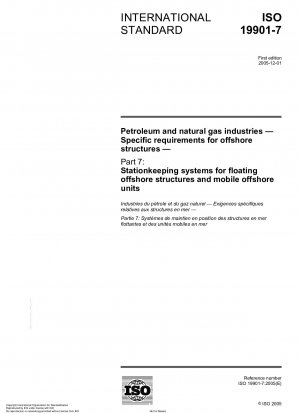ISO 19901-7:2005
Petroleum and natural gas industries - Specific requirements for offshore structures - Part 7: Stationkeeping systems for floating offshore structures and mobile offshore units
- Standard No.
- ISO 19901-7:2005
- Release Date
- 2005
- Published By
- International Organization for Standardization (ISO)
- Status
- 2013-05
- Replace By
- ISO 19901-7:2013
- Latest
- ISO 19901-7:2013
- Scope
- This part of ISO 19901 specifies methodologies for a) the design, analysis and evaluation of stationkeeping systems for floating structures used by the oil and gas industries to support - production, - storage, - drilling, well intervention and production, - production and storage, - drilling, well intervention, production and storage, and b) the assessment of stationkeeping systems for site-specific applications of mobile offshore units (e.g. mobile offshore drilling units, construction units, and pipelay units). Most stationkeeping systems used with the class of floating structures covered by a) are termed “permanent mooring systems”, for which this part of ISO 19901 is applicable to all aspects of the life cycle and includes requirements relating to the manufacture of mooring components, as well as considerations for in-service inspections. Most stationkeeping systems used with mobile offshore units, the class covered by b), are termed“mobile mooring systems”. Throughout this document, the term “floating structure”, sometimes shortened to“structure”, is used as a generic term to indicate any member of the two classes, a) and b). This part of ISO 19901 is applicable to the following types of stationkeeping systems, which are either covered directly in this document or through reference to other guidelines: - spread moorings (catenary, taut-line and semi-taut-line moorings); - single point moorings, anchored by spread mooring arrangements; - dynamic positioning systems; - thruster-assisted moorings. Descriptions of the characteristics and of typical components of these systems are given in Annex A. The requirements of this part of ISO 19901 mainly address spread mooring systems and single point mooring systems with mooring lines composed of steel chain and wire rope. This document also provides guidance on the application of the methodology to synthetic fibre rope mooring systems, and includes additional requirements related to the unique properties of synthetic fibre ropes. The document applies to single anchor leg moorings (SALMs) and other single point mooring systems (e.g. tower soft yoke systems) only to the extent to which the requirements are relevant. The requirements of this document do not apply to the vertical moorings of tension leg platforms (TLPs). The methodology described in this part of ISO 19901 identifies a set of coherent analysis tools that, combined with an understanding of the site-specific metocean conditions, the characteristics of the floating structure under consideration, and other factors, can be used to determine the adequacy of the stationkeeping system to meet the document’s functional requirements.
ISO 19901-7:2005 Referenced Document
- ISO 19900 Petroleum and natural gas industries — General requirements for offshore structures*, 2019-06-14 Update
- ISO 19901-1 Petroleum and natural gas industries - Specific requirements for offshore structures - Part 1: Metocean design and operating considerations*, 2015-10-01 Update
- ISO 19904-1 Petroleum and natural gas industries — Floating offshore structures — Part 1: Ship-shaped, semi-submersible, spar and shallow-draught cylindrical structures*, 2019-05-10 Update
ISO 19901-7:2005 history
- 2013 ISO 19901-7:2013 Petroleum and natural gas industries - Specific requirements for offshore structures - Part 7: Stationkeeping systems for floating offshore structures and mobile offshore units
- 2005 ISO 19901-7:2005 Petroleum and natural gas industries - Specific requirements for offshore structures - Part 7: Stationkeeping systems for floating offshore structures and mobile offshore units
